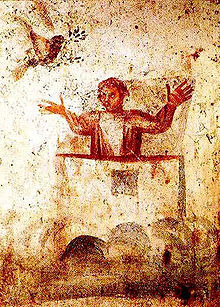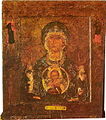Orans


Orans, a loanword from Medieval Latin translated as one who is praying or pleading, also Orant or Orante, is a posture or bodily attitude of prayer, usually standing, with the elbows close to the sides of the body and with the hands outstretched sideways, palms up.[1] It was common in early Christianity and can frequently be seen in early Christian art. In modern times, the orans position is still preserved within parts of the Orthodox, Anglican, Episcopal, Lutheran and Catholic liturgies, Pentecostal and charismatic worship, and the ascetical practices of some religious groups.
History

The orans posture was practiced by both pagans and Jews before it was adopted by the earliest Christians. Christians saw the position as representing the posture of Christ on the Cross; therefore, it was the favorite one of early Christians. Until the 9th century, the posture was sometimes adopted by entire congregations while celebrating the Eucharist.[2] By the 12th century, however, the joining of hands began to replace the orans posture as the preferred position for prayer. It continued to be used at certain points in the liturgies of the Catholic and Orthodox Churches. In the Catholic Mass, it occurs at the orations, the Canon, and the Lord's Prayer.[3]
In the 20th century, the orans posture experienced a revival as a result of its widespread use within Pentecostalism and Charismatic Christianity. Often associated with contemporary worship, the orans posture is once again becoming a common gesture of worship among many Christian groups.[2][4][5]
Depictions in art

Orans was common in early Sumerian cultures: "...it appears that Sumerian people might have a statue carved to represent themselves and do their worshipping for them - in their place, as a stand in. An inscription on one such statue translates, 'It offers prayers.' Another inscription says, 'Statue, say unto my king (god)..."[6] The custom of praying in antiquity with outstretched, raised arms was common to both Jews and Gentiles, and indeed the iconographic type of the Orans was itself strongly influenced by classic representations. But the meaning of the Orans of Christian art is quite different from that of its prototypes.[1]
Numerous Biblical figures, for instance, depicted in the catacombs of Rome — Noah, Abraham, Isaac, Shadrach, Meshach and Abednego, and Daniel in the lion's den — are pictured asking the Lord to deliver the soul of the person on whose tombs they are depicted as he once delivered the particular personage represented. But besides these Biblical Orans figures there exist in the catacombs many ideal figures (153 in all) in the ancient attitude of prayer,[1] representing the deceased's soul in heaven, praying for their friends on earth.[7]
This symbolic meaning accounts for the fact that the great majority of the figures are female, even when depicted on the tombs of men.[citation needed]
One of the most convincing proofs that the Orans was regarded as a symbol of the soul is an ancient lead medal in the Vatican Museum showing the martyr, St. Lawrence, under torture, while his soul, in the form of a female Orans, is just leaving the body. An arcosolium in the Ostrianum cemetery represents an Orans with a petition for her intercession: Victoriæ Virgini ... Pete ... The Acts of St. Cecilia speaks of souls leaving the body in the form of virgins: "Vidit egredientes animas eorum de corporibus, quasi virgines de thalamo", and so also the Acts of Sts. Peter and Marcellinus.[1]
Very probably the medieval representations of a diminutive body, figure of the soul, issuing from the mouths of the dying were reminiscences of the Orans as a symbol of the soul. The earlier Orantes were depicted in the simplest garb, and without any striking individual traits, but in the 4th century the figures become richly adorned, and of marked individuality, an indication of the approach of historic art. One of the most remarkable figures of the Orans cycle, dating from the early 4th century, is interpreted by Wilpert as the Blessed Virgin interceding for the friends of the deceased. Directly in front of Mary is a boy, not in the Orans attitude and supposed to be the Divine Child, while to the right and left are monograms of Christ.[1]
The Platytéra, a standard hagiographic depiction on the Virgin Mary as "Wider than the Heavens", is an orans-type depiction usually placed on the half-dome above the altar of Byzantine-style churches, and facing down the nave.
Some Orans-type Eastern Orthodox icons of the Virgin Mary
-
Orans (catacombs of Rome), first half of IV c.
-
Orans of Kiev. Mosaic. XI c.
-
Orans in Kiev Saint Sophia cathedral.
-
Our Lady of the Sign icon. Veliky Novgorod. First half of XII c.
-
Inexhaustible Chalice icon. Serpukhov. XIX c.
See also
References
- ^ a b c d e Herbermann, Charles, ed. (1913). . Catholic Encyclopedia. New York: Robert Appleton Company.
- ^ a b Stephen Burns, SCM Studyguide to Liturgy (Hymns Ancient & Modern Ltd, 2006), 62.
- ^ "Liturgical Gestures." New Catholic Encyclopedia. 2nd ed. Vol. 8. Detroit: Gale, 2003. 646-650. Gale Virtual Reference Library. Web. 7 Feb. 2012.
- ^ Paul Harvey and Philip Goff, The Columbia documentary history of religion in America since 1945 (Columbia University Press, 2005), 347.
- ^ Larry Witham, Who shall lead them?: the future of ministry in America (Oxford University Press, Jul 1, 2005), 134.
- ^ Benton, DiYanni, J. R, R (2008). Arts and Culture: An Introduction to the Humanities. Upper Saddle, New Jersey: Prentice Hall. p. 9. ISBN 978-0-536-41910-1.
{{cite book}}: CS1 maint: multiple names: authors list (link) - ^ Wilpert "Ein Cyklus christologischer Gemälde aus der Katakombe der Heiligen Petrus und Marcellinus" (Freiburg, 1891);
External links
![]() This article incorporates text from a publication now in the public domain: Herbermann, Charles, ed. (1913). "Orans". Catholic Encyclopedia. New York: Robert Appleton Company.
This article incorporates text from a publication now in the public domain: Herbermann, Charles, ed. (1913). "Orans". Catholic Encyclopedia. New York: Robert Appleton Company.





